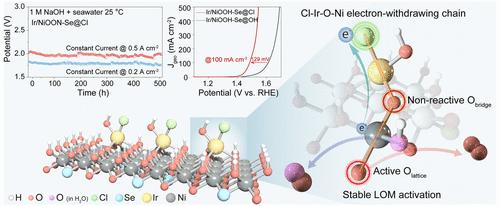当前位置:
X-MOL 学术
›
J. Am. Chem. Soc.
›
论文详情
Our official English website, www.x-mol.net, welcomes your
feedback! (Note: you will need to create a separate account there.)
Lattice Oxygen Mechanism Induced on Nickel Sites by Cl– Adsorption for Efficient Seawater Oxidation Reaction
Journal of the American Chemical Society ( IF 14.4 ) Pub Date : 2025-06-04 , DOI: 10.1021/jacs.5c04206
Qihao Sha, Tianshu Gao, Li Yan, Wei-Hsuan Hung, Ching-Yu Chiang, Daojin Zhou, Bin Liu, Yun Kuang, Xiaoming Sun
Journal of the American Chemical Society ( IF 14.4 ) Pub Date : 2025-06-04 , DOI: 10.1021/jacs.5c04206
Qihao Sha, Tianshu Gao, Li Yan, Wei-Hsuan Hung, Ching-Yu Chiang, Daojin Zhou, Bin Liu, Yun Kuang, Xiaoming Sun

|
Efficient seawater oxidation reaction is crucial for advancing hydrogen fuel production. Developing highly efficient oxygen evolution reaction (OER) catalysts that follow the lattice oxygen mechanism (LOM) can effectively mitigate undesirable chloride oxidation side reactions in seawater electrolysis and reduce energy consumption. Herein, we propose a Cl–-mediation strategy that is able to shift the OER mechanism from the adsorbate evolution mechanism (AEM) to LOM on nickel sites. By loading highly dispersed Ir onto Ni-based precursors (e.g., NiSe, Ni(OH)2, NiS2 and NiSOH), we exploit the robust coordination interaction between Ir and Cl– in seawater to establish a Cl–Ir–O–Ni electron-withdrawing chain from Ni to Cl, which strengthens Ni–O covalency in situ during the OER, thereby activating lattice oxygen around the Ni sites in seawater. As a result, the Cl-modified Ir/NiOOH-Se@Cl catalyst requires an overpotential of only 313 mV to achieve an OER current density of 0.5 A cm–2, demonstrating a reduction of 147 mV compared to that in alkaline condition (Ir/NiOOH-Se@OH) and also maintaining stable operation at 0.5 A cm–2 for 500 h. Our work provides a novel and intriguing concept for regulating local lattice oxygen activity toward developing highly efficient oxygen electrocatalysts for clean energy productions.
中文翻译:

Cl– 吸附在镍位上诱导晶格氧机制,实现高效的海水氧化反应
高效的海水氧化反应对于推进氢燃料生产至关重要。开发遵循晶格氧机制 (LOM) 的高效析氧反应 (OER) 催化剂可以有效减轻海水电解中不良的氯化物氧化副反应并降低能耗。在此,我们提出了一种 Cl–-介导策略,该策略能够将 OER 机制从吸附物析出机制 (AEM) 转变为镍位点上的 LOM。通过将高度分散的 Ir 加载到 Ni 基前驱体(例如 NiSe、Ni(OH)2、NiS2 和 NiSOH)上,我们利用海水中 Ir 和 Cl– 之间的稳健配位相互作用,建立从 Ni 到 Cl 的 Cl-Ir-O-Ni 吸电子链,从而在 OER 过程中加强 Ni-O 原位共价性,从而激活海水中 Ni 位点周围的晶格氧。因此,Cl 改性的 Ir/NiOOH-Se@Cl 催化剂只需要 313 mV 的过电位即可实现 0.5 A cm–2 的 OER 电流密度,与碱性条件 (Ir/NiOOH-Se@OH) 相比降低了 147 mV,并且在 0.5 A cm–2 下保持稳定运行 500 h。我们的工作为调节局部晶格氧活性提供了一个新颖而有趣的概念,以开发用于清洁能源生产的高效氧电催化剂。
更新日期:2025-06-04
中文翻译:

Cl– 吸附在镍位上诱导晶格氧机制,实现高效的海水氧化反应
高效的海水氧化反应对于推进氢燃料生产至关重要。开发遵循晶格氧机制 (LOM) 的高效析氧反应 (OER) 催化剂可以有效减轻海水电解中不良的氯化物氧化副反应并降低能耗。在此,我们提出了一种 Cl–-介导策略,该策略能够将 OER 机制从吸附物析出机制 (AEM) 转变为镍位点上的 LOM。通过将高度分散的 Ir 加载到 Ni 基前驱体(例如 NiSe、Ni(OH)2、NiS2 和 NiSOH)上,我们利用海水中 Ir 和 Cl– 之间的稳健配位相互作用,建立从 Ni 到 Cl 的 Cl-Ir-O-Ni 吸电子链,从而在 OER 过程中加强 Ni-O 原位共价性,从而激活海水中 Ni 位点周围的晶格氧。因此,Cl 改性的 Ir/NiOOH-Se@Cl 催化剂只需要 313 mV 的过电位即可实现 0.5 A cm–2 的 OER 电流密度,与碱性条件 (Ir/NiOOH-Se@OH) 相比降低了 147 mV,并且在 0.5 A cm–2 下保持稳定运行 500 h。我们的工作为调节局部晶格氧活性提供了一个新颖而有趣的概念,以开发用于清洁能源生产的高效氧电催化剂。


















































 京公网安备 11010802027423号
京公网安备 11010802027423号